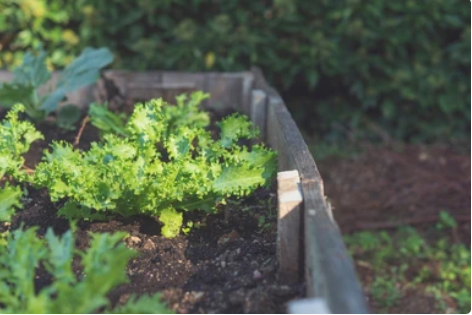Endive and Escarole Fertilization Requirements
It is essential to highlight that no two fields are the same, nor can anyone advise a farmer on fertilization methods without considering the soil test data, tissue analysis, and crop history of a specific field. However, below, some common schemes and fertilization strategies used by many farmers are presented.
Generally, every 1 ton of harvest is removed from the ground: N: 5 kg (4.5 lb/acre), P2O5: 1.6 kg (1.4 lb/acre), and K₂O 4 kg (3.6 lb/acre). As a result, the fertilization schedule and amounts used should sufficiently cover the nutrient needs to maximize production and quality. Many producers start by applying 20-40 tons of well-rotted manure per hectare (8-16 tons/acre) in early spring or fall (around 2 months before planting the crop) as a basal fertilizer to improve soil fertility. Cottonseed meal is used in some cases as well. Farmers incorporate it after or during the manure application by plowing at a depth of 30-40 cm (12- 16 inches). It is essential to avoid using fresh manure since problems with weeds and plant toxicity may arise.
The next applications of chemical and synthetic fertilizers should be based on the results of the soil analysis data. While numerous farmers apply all three basic nutrients (nitrogen, phosphorus, and potassium), many fields already have sufficient amounts of phosphorus. In these cases, the growers are advised to exclude this nutrient or apply less phosphorus fertilizers.
The common practice during the entire growing period is to add per hectare:
- P2O5 80-120 kg or 500-600 kg of phosphorus fertilizer per hectare (such as 0-20-0) (71-107 lb and 446-535 lb per acre, respectively),
- K₂O 150-240 kg per hectare (or 300-400 kg 0-0-50), (134-214 lb or 268- 357lb/acre, respectively) and
- N 100-150 kg (or 400-600 kg 26-0-0), (89-134 lb or 357-535 per acre).
As an alternative, a complete fertilizer (10-10-10) can be applied at a rate of 970 kg per hectare (or 870 lbs./acre). Remember that for higher efficiency, farmers are advised to prefer band application (and incorporation into the soil) instead of broadcasting. In the second case, P and K fertilizers should be increased by 1.5-2 times.
Phosphorus fertilizers are also released into the soil during the field preparation, while the nitrogen is divided into 2-3 surface applications every 20 days, with the first to be performed 3-4 weeks after planting. In general, endive and escarole have moderate nitrogen requirements, and over-fertilization should be avoided since it can increase the risk of rotting and tip burning of the leaves. On the other hand, endive needs high levels of potassium (K). Therefore, they apply a fertilizer rich in potassium at least 2,5 times higher than nitrogen (ask your local licensed agronomist). Occasionally, growers use ammonium sulfate (NH₄)₂SO₄, 881 lbs (400 kg) per hectare. While the crop thrives in slightly acidic soils, a low pH may lead to Mg deficiency (below 67-78 kg/ha or 60-70 lb/acre). A similar problem may arise when there is a surplus of potassium in the soil. To correct that, a farmer may need to perform a foliar spray with a 2% magnesium sulfate solution. Farmers can use 28 lb Mg per hectare (25 lb/acre) for soil applications. Zinc, Sulfur, and Boron may also be used when the soil analysis shows nutrient amounts less than 5.6 kg/ha, 11.2 kg/ha, and 1.2 kg/ha (5 lb/acre, 10 lb/acre, and 1 lb/acre), respectively.
Most fertilizers are applied as granules directly to the soil. The granules should not be in direct contact with the young plants to avoid damaging them. To improve the incorporation of fertilizers into the soil and the absorption of nutrients from the plants, farmers prefer to apply them before rainfall or irrigate. In the case of drip irrigation, growers choose to perform all side-dressing fertilization as fertilizers with water-soluble fertilizers. It is essential to follow manufacturer instructions before injecting this fertilizer into the irrigation systems.
However, these are just some examples. No one should follow them without doing personal research. Every field is different and has different needs. Checking the soil condition and pH is vital before applying any fertilization method. You can consult your local licensed agronomist.
Further Reading
10 Interesting Facts about Endive and Escarole
Endive and Escarole: Health Benefits and Nutritional Value
Endive & Escarole Plant Information and Environmental Requirements
How to Grow Endive (and Escarole) at Home
How to Grow Endive -Escarole for Profit
Endive (and Escarole) Soil Requirements, Preparation and Planting
Endive and Escarole Water Requirements & Irrigation Systems
Endive and Escarole Fertilization Requirements
Endive and Escarole Blanching, Yield, Harvest and Storage
Endive and Escarole Pests and Diseases
References
- https://edis.ifas.ufl.edu/publication/CV008
- https://eap.mcgill.ca/CPLV_2.htm
- https://edis.ifas.ufl.edu/publication/CV008
- https://extension.umn.edu/vegetables/growing-lettuce-endive-and-radicchio#soil-testing-and-fertilizer-394060
- https://www.cabidigitallibrary.org/doi/10.1079/cabicompendium.13408
- http://aesl.ces.uga.edu/publications/soil/cropsheets.pdf
- https://nevegetable.org/crops/lettuce-endive-and-escarole










































































